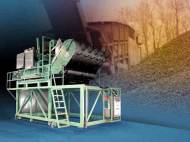Siemens mechanically enhanced biodrying
 Back in March, Siemens announced that the Chinese city of Shenyang will employ their Mechanically Enhanced Biodrying (MEB) process to dry 1,000 metric tons of wet sludge per day. Unlike other technologies which process the sludge from wastewater in order to create fertilizers, the new process does not require any outside source of heat, thus reducing operational costs by 30 percent compared to thermal drying processes.
Back in March, Siemens announced that the Chinese city of Shenyang will employ their Mechanically Enhanced Biodrying (MEB) process to dry 1,000 metric tons of wet sludge per day. Unlike other technologies which process the sludge from wastewater in order to create fertilizers, the new process does not require any outside source of heat, thus reducing operational costs by 30 percent compared to thermal drying processes.
The plants have been landfilling or land applying wet (20% solids) sludge, and China recently passed a law that sludge must be a minimum of 60% solids for land application and/or landfill disposal. The Shenyang plant is designed to dewater 1,000 wet tons per day of wastewater sludge, from 20% solids to 65% solids without the need to add heat.
In order to attain this high percentage of solid matter, the sludge must be dried. This can be accomplished very rapidly with thermal processes, which demands a great deal of energy. Unlike thermal drying processes where heat is used to dry the sludge, mechanically enhanced biodrying employs the energy produced by microbes in the sludge. Alternatively, the sludge can be dried with help from the sun, but this process can last up to two months.
The solution devised by Siemens increases the solids content of the sewage sludge from 20 to 65 percent within about 22 days. The heat required for the drying is produced by biological processes, since microbes which break down nutrients in the sludge generate some heat in the process. The process does require the usage of up to 2% (by weight) of additional corn waste in order to improve the process, but it doesn’t require other carbon-rich amendments or bulking agents required by most other sludge composting processes. The only other type of energy needed to keep the biological process running is the mechanical energy to aerate and mix the sludge.
The sewage sludge is automatically aerated and mixed in a controlled process. The system is enclosed, so that any odors can be trapped with a biofilter. After the mechanically enhanced biodrying process is done, the resulting product can be used as fertilizer or fuel, or it can be disposed of in landfills.
A six-month pilot test at a composting plant in the town of Merrimack in the U.S. state of New Hampshire has shown that this technique works even at ambient temperatures as low as -10°C (14°F). The new plant in the city of Shenyang will start with its operation in the beginning of the fall of 2012, and it will be one of the largest sewage sludge treatment plant in the world that uses a non-thermal technique.









Leave your response!